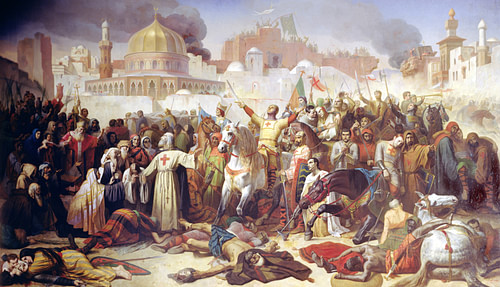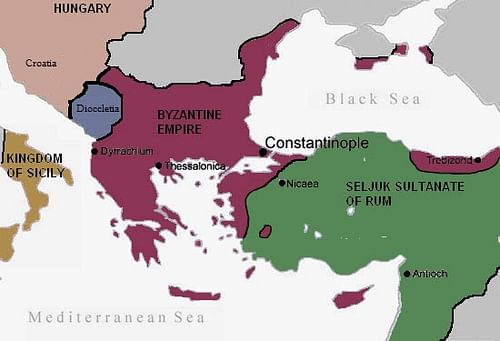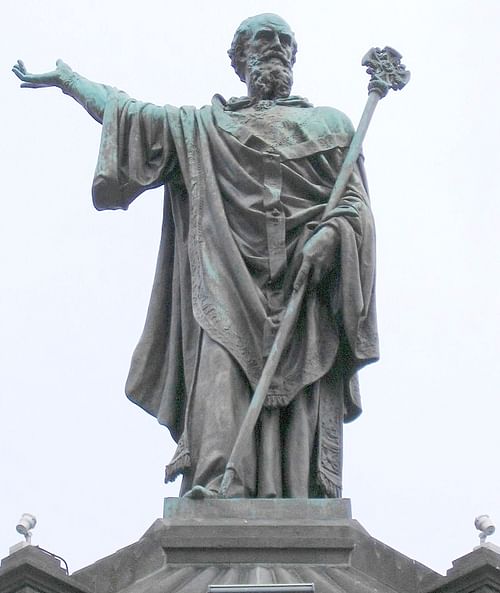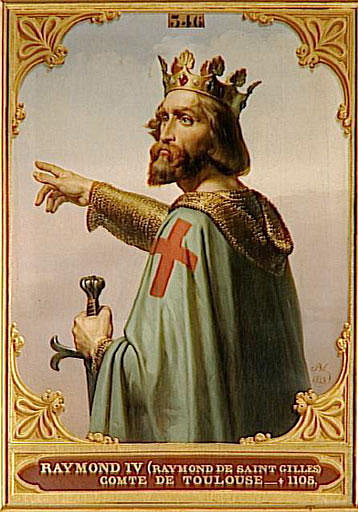What Would Happen if the Crusades Happend Again What Would Happen if the Crusades Happen Again
The Crusades were a series of military campaigns organised by Christian powers in order to retake Jerusalem and the Holy Land back from Muslim control. There would be eight officially sanctioned crusades between 1095 CE and 1270 CE and many more unofficial ones. Each campaign met with varying successes and failures but, ultimately, the wider objective of keeping Jerusalem and the Holy Land in Christian hands failed. Nevertheless, the appeal of the crusading ideal continued right up to the 16th century CE, and the purpose of this commodity is to consider what were the motivating factors for crusaders, from the Pope to the humblest warrior, particularly for the very first campaign which established a model to be followed thereafter.

Taking of Jerusalem by the Crusaders
Who Wanted What?
Why the Crusades happened at all is a circuitous question with multiple answers. Equally the historian J. Riley-Smith notes:
It cannot be stressed often plenty that crusades were arduous, disorientating, frightening, dangerous, and expensive for participants, and the continuing enthusiasm for them displayed over the centuries is non like shooting fish in a barrel to explain. (x)
An estimated 90,000 men, women, and children of all classes were persuaded past political and religious leaders to participate in the First Crusade (1095-1102 CE), and their various motivations, along with those of the political and religious leaders of the time, must each be examined to accomplish a satisfactory explanation. Although we tin never know exactly the thoughts or motivation of individuals, the full general reasons why the crusading platonic was promoted and acted upon tin can exist summarised according to the following fundamental leaders and social groups:
- The Byzantine Emperor - to regain lost territory and defeat a threatening rival state.
- The Pope - to strengthen the papacy in Italy and achieve ascendancy as head of the Christian church.
- Merchants - to monopolise of import trading centres currently nether Muslim command and earn money shipping crusaders to the Middle Due east.
- Knights - to defend Christianity (its believers and holy places), follow the principles of knightly and proceeds material wealth in this life and special favour in the next one.
The Byzantine Empire
The Byzantine Empire had long been in command of Jerusalem and other sites holy to Christians but, in the latter decades of the 11th century CE, they lost them dramatically to the Seljuks, a Turkish tribe of the steppe. The Seljuks, already having made several raids into Byzantine territory, shockingly defeated a Byzantine army at the Battle of Manzikert in ancient Armenia in August 1071 CE. They even captured the Byzantine emperor Romanos Iv Diogenes (r. 1068-1071 CE), and although he was released for a massive ransom, the emperor too had to hand over the important cities of Edessa, Hieropolis, and Antioch. The defeat astonished Byzantium, and there followed a scramble for the throne which even Romanos' return to Constantinople did not settle. Information technology also meant that many of the Byzantine commanders in Asia Modest left their commands to stake their claim for the throne in Constantinople.
The sword of Christendom could prove a very useful weapon in preserving the crown of Byzantium.
Meanwhile, the Seljuks took full advantage of this armed forces neglect and, c. 1078 CE, created the Sultanate of Rum with their uppercase at Nicaea in Bithynia in northwest Asia Minor, which was captured from the Byzantines in 1081 CE. The Seljuks were even more aggressive, though, and by 1087 CE they controlled Jerusalem.
Several Byzantine emperors came and went but some stability was achieved during the reign of Alexios I Komnenos (r. 1081-1118 CE), himself a veteran of Manzikert. Alexios could non cease the Seljuks though, and he had only himself to arraign for his territorial losses as it was he who had weakened the military provinces (themes) in Asia Minor. Alexios had done this in fear of the rising ability, and thus potential threat to himself, of the theme commanders. Instead, he had bolstered the garrisons of Constantinople. The emperor had besides been doubtful of the loyalty of his Norman mercenaries, given the Norman control of Sicily and recent attacks in Byzantine Hellenic republic. Seeing the Seljuk control of Jerusalem every bit a means to tempt European leaders into activity, Alexios appealed to the west in the spring of 1095 CE to aid kick the Seljuks out of non but the Holy Land but also all those parts of the Byzantine Empire they had conquered. The sword of Christendom could prove a very useful weapon in preserving the crown of Byzantium.

The Byzantine Empire c. 1090 CE
The Pope
Pope Urban II (r. 1088-1099 CE) received Alexios' entreatment in 1095 CE, but it was not the first fourth dimension the Byzantine emperor had asked and got papal help. In 1091 CE the pope had sent troops to help the Byzantines against the Pecheneg steppe nomads who were invading the northern Danube surface area of the empire. Urban Ii was once again disposed to assist four years after for various reasons. A crusade would increase the prestige of the papacy, as it led a combined western army, and consolidate its position in Italia itself, having experienced serious threats from the Holy Roman Emperors in the previous century which had even forced the popes to relocate away from Rome.
Urban 2 also hoped to reunite the Western (Cosmic) and Eastern (Orthodox) Christian churches, with himself at its head, above the Patriarch of Constantinople. The two churches had been split since 1054 CE over disagreements about doctrine and liturgical practices. The Crusades could be given wider appeal by playing on the threat of Islam to Christian territories and the Christians living there. Most important of all though was the loss of Christian control of the Holy Land with its unique sites of historical significance to Christianity, particularly the tomb of Jesus Christ, the Holy Sepulchre in Jerusalem. On top of that, Spain was a reminder of how precarious the Christian earth'south situation really was. By 1085 CE half of Spain was back in Christian hands, and the Normans had wrested Sicily back to the Christian fold, just the Muslim threat in Europe remained a potent i, something Urban II could at present remind people of. The appeal of Alexios I Komnenos had all sorts of political and religious advantages.
The idea of sin was peculiarly prevalent & then Pope Urban 2's promise of immunity from its consequences would have appealed to many.
On 27 November 1095 CE, Urban II chosen for a crusade in a speech during the Quango of Clermont, French republic. The message, known every bit the Indulgence and aimed specifically at knights, was loud and articulate: those who defended Christendom would exist embarking on a pilgrimage, all their sins would be washed away and their souls would reap untold rewards in the next life. In medieval Europe, Christianity permeated every aspect of daily life, pilgrimage was common, monasteries were full and the number of newly created saints booming. The idea of sin was especially prevalent and so Urban II's promise of immunity from its consequences would accept appealed to many. Crucially, too, the church could condone a campaign of violence because it was one of liberation (non attack) and it had a just and righteous aim.
Urban II embarked on a preaching tour in France during 1095-6 CE to recruit crusaders, where his message was spiced up with exaggerated tales of how, at that very moment, Christian monuments were existence defiled and Christian believers persecuted and tortured with impunity. Embassies and letters were dispatched to all parts of Christendom. Major churches such as those at Limoges, Angers, and Tours acted as recruitment centres, as did many rural churches and specially the monasteries. Beyond Europe, warriors gathered throughout 1096 CE, prepare to embark for Jerusalem.

Pope Urban 2
Merchants
Merchants, although not then involved in the Showtime Crusade, certainly became more involved from 1200 CE every bit they wanted to open up trade routes with the East, even to control such prosperous trade centres equally Antioch and Jerusalem. Farther, merchants could make a handsome profit from ferrying crusaders across the Mediterranean. Indeed, from the Second Crusade (1147-1149 CE), lucrative contracts were drawn up beforehand to ship armies across to the Middle East. The Italian trading states of Venice, Pisa, and Genoa, as well as Marseille in French republic, were particular rivals, and each was eager to proceeds a monopoly on east-west merchandise. It should be remembered, though, that these cities also provided enough of religious zealots keen to fight for the Christian crusade and not merely make cash from it.
European Knights
By the 11th century CE club in medieval Europe had go increasingly militarised. Central governments simply did not take the means to govern on the basis across every part of their territories. Those who did govern in do at local level were large landowners, the barons who had castles and a force of knights to defend them. Knights, even kings and princes, too, joined the crusades for religious principles, a reward in the afterlife perhaps or the pure platonic that Christians and Christian sites must be protected from the infidel. It is of import perhaps to note that there was just a very express racial or religious hatred specifically against those who had usurped the Holy Country. Although the clergy certainly used the tools of propaganda available to them and delivered recruitment sermons across Europe, the fact that Muslims were virtually unknown to their audience meant that whatever demonisation had footling value. Muslims were the enemy considering they had taken Christian holy sites, not directly because they were Muslims. This important point is stressed by the historian M. Bull in the post-obit terms:
Pop agreement of the crusades nowadays tends to call back in terms of a bang-up conflict between faiths fuelled by religious fanaticism. This perception is jump upwards with modern sensibilities near religious discrimination, and it also has resonances in reactions to current political conflicts in the Near East and elsewhere. But it is a perspective which, at least equally far as the First Crusade is concerned, needs to be rejected. (Riley-Smith, 18)
For willing knights in that location was likewise the take a chance to win booty, lands, and perhaps fifty-fifty a championship. Land might take to be sold and equipment was expensive, though, and then at that place was certainly a major financial cede to be made at the starting time. Monasteries were on hand to arrange loans for this who struggled to meet the initial costs. There was, as well, the idea of chivalry - that a knight should 'practice the right thing' and protect not only the interests of their church and god but also those of the weak and oppressed. In the 11th century CE the code of chivalry was notwithstanding in its infancy then was more than concerned with upholding a brotherhood of arms. Thus the relevance of chivalry as motivation to join the Kickoff Crusade is perhaps more to do with the importance of beingness seen to practise what was expected of one by 1's peers, and only in later crusades would its moral aspects go more prominent and the bulletin fuelled by songs and poems of daring crusader deeds.

Raymond IV of Toulouse
Many knights, besides, were simply obliged to join their baron or lord as part of the service they performed to earn a living. Technically, crusaders were volunteers but one can imagine that staying at home to tend the castle fireplace while one's lord and benefactor rode off to the Middle East was not a applied option for knights in service. In improver, many knights followed their fathers or brothers as ties of kinship and common protection were strong. As the Crusades continued, traditions and expectations were established inside families and then that at to the lowest degree one member of each generation was expected to keep to fight for the crusade.
Citizens
Besides knights, the idea of a crusade had to entreatment to ordinary pes soldiers, archers, squires, and all the non-combatants needed to back up the cavalry units of knights when on campaign. That the platonic did appeal to ordinary folk, including women, is illustrated by such events every bit the people's ground forces led by the preacher Peter the Hermit which gathered and arrived in Constantinople in 1096 CE. The unruly ground forces, sometimes referred to as the "People's Crusade", were promptly shipped by Alexios I Komnenos to Asia Pocket-sized, where, ignoring the Byzantine's advice, they were ambushed and wiped out near Nicaea past a Seljuk ground forces on 21 October 1096 CE.
Besides the prestige and honour of 'taking up the cross', so called because crusaders wore a badge on the shoulder on their tunic or cloak, there were some practical benefits for ordinary citizens, at least by the 13th century CE. These included a delay in feudal service, a court case might be speeded upward earlier departure, an exemption from certain taxes and tolls, a postponement of the repayment of debts, and even a release from excommunication.
Conclusion
As the historian C. Tyerman points out in his God's War, in many ways 1095 CE was the 1914 CE of the Middle Ages - a perfect storm of moral outrage, personal gain, institutionalised political and religious propaganda, peer pressure level, societal expectations, and a thirst for adventure, which all combined to inspire people to exit their homes and embark on a perilous journey to a destination they knew nothing about and where they might meet glory and expiry or just death. The fervour did not dissipate either. If anything, the success of the First Crusade and the recapture of Jerusalem on 15 July 1099 CE just inspired more people to 'take the cross'. The idea of crusading spread to such endeavours every bit liberating Spain from the Moors (the Reconquista) and attacking minority targets in Europe such as the Jews, pagans, and heretics (the Northern Crusades). Orders of knights were created to defend the territories gained in the Heart East, and taxes were continuously raised to fund the crusades which followed as Muslim and Christian armies enjoyed both successes and failures, constantly keeping cartographers busy for the side by side four centuries.
This article has been reviewed for accuracy, reliability and adherence to academic standards prior to publication.
Source: https://www.worldhistory.org/article/1249/the-crusades-causes--goals/
0 Response to "What Would Happen if the Crusades Happend Again What Would Happen if the Crusades Happen Again"
Post a Comment